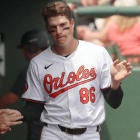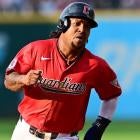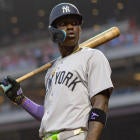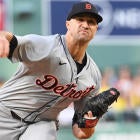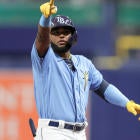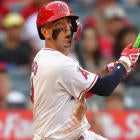Note: FanDuel hosts one-day Fantasy Baseball contests. They're $3 to enter and pay out real cash prizes. Sign up now!
The utility of batter vs. pitcher data in predicting future outcomes is a debate that rages -- yes, "rages" -- through the Daily Fantasy Sports world constantly. Every day in his DFS column, Heath Cummings provides some BvP highlights, with the following caveat:
"Batter vs. pitcher splits are controversial in the DFS world because of the disagreement over what they mean. I'm not here to fuel that discussion in either direction, but I have decided to add this section for information if for nothing else. Use it, disregard it, or laugh at it. Your choice."
The reason this data is so contentious is that the sample sizes are often so small. In Monday's column, Evan Longoria vs. CC Sabathia, Dustin Pedroia vs. Scott Kazmir and Billy Butler vs. Rick Porcello are the only three among the seven listed with a sample size of more than 17 at-bats. There isn't much you can take from that kind of sample.
The relevant question isn't, "Do some hitters hit certain pitchers better or worse?" That is a question with an obvious answer: "Yes." Intuitively, we all understand that this is so. The controversy doesn't stem from that question, but rather from a few other ones. Specifically, at what point a BvP number becomes statistically significant, and what the mechanisms behind a specific batter's failure or success against a specific pitcher is.
The first question is more difficult to answer, because you are comparing a sample size of thousand's of at-bats against all pitchers vs. maybe a few dozen against specific individuals. How can you possibly know when to weight the latter over the former, to a point where you can say with a high degree of certainty it has predictive power. At what point do we accept that a career .250 hitter is suddenly a .300 guy based on who is on the mound.
The latter question, regarding the mechanisms is one we can at least try to answer. Let's take a look at the three BvP All-Stars with the most robust track records Monday, and see if we can divine anything from the numbers.
Evan Longoria .414/.521/.862 in 58 AB vs. CC Sabathia
Longoria has a career .924 OPS against left-handed pitchers, so it isn't terribly surprising that he would find success against any given lefty. Of course, Sabathia isn't just "any given lefty." He has been one of the best in baseball for years, with a 3.48 ERA since Longoria entered the league in 2008 even with his struggles over the last few years.
Typically, pitchers will try to neutralize batters of the opposite hand with their changeup, and Sabathia is no different. He throws his changeup 22.4 percent of the time against right-handed batters, while he rarely throws it to lefties, relying on his wipeout slider to demolish them. That trend typically works out for Sabathia, as RHB hit just .235 with a .109 ISO against his changeup in his career, per BrooksBaseball.net.
Longoria isn't your typical hitter, as he hits .325 with a .528 slugging percentage against changeups from lefties. Interesting, he actually struggles against sliders from lefties, hitting .183 with a .140 ISO. Maybe Sabathia needs to attack him more like a lefty?
Dustin Pedroia .500/.596/.868 in 38 AB vs. Scott Kazmir
Pedroia has faced Kazmir exactly twice since the southpaw made his return to the majors, but he has continued his assault on him by going 2 for 5 with one home run, one double and two RBI over the last two seasons. However, much of his success came from 2007-2010, when Kazmir was a much different pitcher, one who struggled badly with his command on a nightly basis.
This is probably one of those situations where we shouldn't take anything from the BvP data. Most of it is too old to really tell us anything about where these two players stand today.
Billy Butler .347/.347/.530 in 49 AB vs. Rick Porcello
What happens when a strength meets a strength? Porcello has been one of baseball's most single-minded chasers of groundballs since he entered into the league, and Butler likes to spray groundballs all over the field; that's why his career BABIP is so high and his power so low, relative to expectations.
One good thing about groundballs is, they tend to go for hits relatively often, compared to other types of batted balls. A groundball pitcher going against a groundball hitter could be a recipe for some high average production, and that's exactly what we see with Butler vs. Porcello, who has 17 hits in 49 at-bats, 12 of which are singles. The combination of a low strikeout rate going each way also means you should see plenty of balls put in play, which equals a greater chance for production on any given game.
The problem with BvP data, as you can see, is the surface doesn't necessarily tell us much. Maybe Dustin Pedroia really does just own Kazmir, but it's awfully hard to look at that sample, and the way he has come by those numbers and feel very confident that it means something.
However, there are larger trends going on with the other two matchups that might be a bit more meaningful. Of course, identifying those trends might be more work than the average DFS player is willing or able to do manually. Your best bet is always going to be to default to what the larger sample sizes indicated.
You might miss out on the outliers who really have mastered specific pitchers, but that might be better than chasing nonexistent rabbits down a hole that might lead nowhere.








